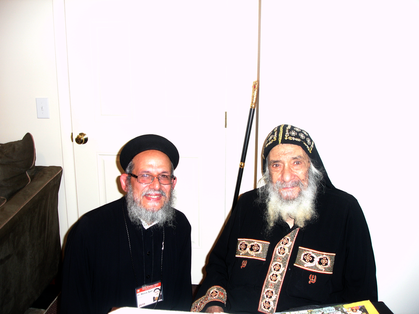 On Tuesday, August 3rd, 2010, His Holiness Pope Shenouda III met with Fr. Metias Ibrahim. During the meeting, Fr. Metias updated Sayedna about the latest news on the new church project progress which is about to be completed very soon. Fr. Metias also invited Sayedna to concecrate the new church once the project is completed.
The meeting was during the Annual Coptic Clergy Seminar that was held at the Virgin Mary Spiritual Vineyard in Boston (Massachusetts, USA) from August 2nd – 4th, 2010 under the leadership and presence of H.H. Pope Shenouda III and the participation of eighteen honoured bishops and approximately 250 reverend priests.
We thank our beloved father H.H. Pope Shenouda III for his paternal love and care for his children and we pray that the Lord would grant him many more peaceful years shepherding his flock in purity and righteousness.
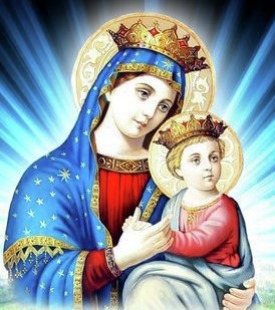 "Awake, O My Harp, Your Chords,
In Praise of the Virgin Mary!
Lift Up Your Voice and Sing
The Wonderful History of this Virgin,
The Daughter of David,
Who Gave Birth to the Life of the World!"
-- St. Ephram the Syrian
As Biblical history has recorded, St. Mary is the central figure in the two Gospel accounts of the birth of the Lord Jesus Christ. The "Mother of God" is seldom mentioned in the New Testament outside of the birth narratives in the opening chapters of St. Matthew and St. Luke. The name of St. Mary is mentioned only once in the Holy Gospel of St. Mark and the Holy Book of Acts. The Blessed Virgin is never explicitly named in the New Testament Letters. The name of St. Mary is only "referred to" in two episodes written by St. John in his Holy Gospel.
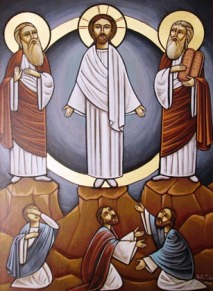 During the month of August, the Coptic Church celebrates the Feast of the Transfiguration of our Lord Jesus Christ on Mount Tabor. The Feast of the Transfiguration is considered one of the seven Minor Feasts of the Lord. The Transfiguration is mentioned in Matthew 17:1-13, Mark 9:2-13, and Luke 9:28-36.
It is stated in both St. Matthew's and St. Mark's Holy Gospels those six days after the Lord's conversation with His disciples regarding the Cross-, He took St. Peter, St. James and St. John on a high mountain and was transfigured before them. St. Luke alludes to the same story but the length after the Lord's conversation was eight days. Is there a contraindication in Holy Scripture? No, it is thought that St. Luke counted the day of His conversation about the Cross-and the day of the Transfiguration; and that St. Matthew and St. Mark did not count those two days. This explains why St. Luke used the phrase, "about eight days after," while St. Matthew and St. Mark mentioned that it "was after six days."
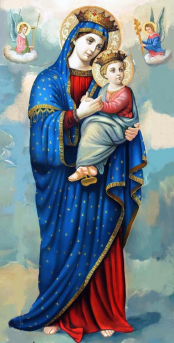 LIFE OF HUMILITY
Humility was a fundamental condition for her of whom the Lord of Glory will be born. It was indispensable that He would be born from a humble person, who could bear the glory of the divine Incarnation from her, the glory of the coming of the Holy Spirit in her, and the glory of the nativity of the Lord from her, and the glory of all the generations blessing her, and the humility of Elizabeth in front of her saying to her: "But why is this granted to me, that the mother of my Lord should come to me?" (Luke 1:43). Likewise to bear the glory of all the apparitions of angels, and the worship of the Magi in front of her Son, and the many miracles which happened by her son in the land of Egypt, and the light of this Son in her bosom. That is why, "the fullness of the time" (Gal. 4:4) waited for this human being from whom the Son of God was born.
This humility was manifested in her life, as we shall see: The angel announced to her that she will become the mother of the Lord, but she said: "Behold the maid-servant of the Lord" (Luke 1:38), that is his slave and his maiden. The magnificent glory which was given to her, absolutely did not decrease by her humility. But rather it was because of this humility that the Lord granted her that glory. "For He has regarded the lowly state of His maidservant" and made great things for her (Luke 1: 48, 49).
The humility of the Virgin was also manifested in her going to Elizabeth in order to serve her, during the period of her pregnancy. As soon as she heard that she was pregnant, in her sixth month, she traveled to her in a tiring journey across the mountains. She remained with her for three months, till her days were complete to give birth (Luke 1: 39-56). She did so while she was pregnant with the Lord of glory. Her lack of talking about the glories of the divine Incarnation, is a sign of her humility.
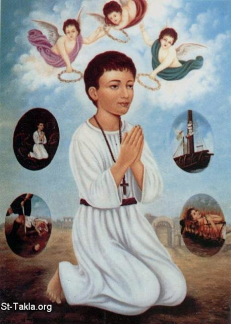 On this day, Apip 24th (July 31st), we celebrate the martyrdom of Saint Abanoub, the child martyr. Saint Abanoub was only twelve years old when he was martyred by the Roman ruler. On July 31 our Church celebrates his death, as the day of his birth into eternal life.
Saint Abanoub's relics, as well as the relics of many Christians who died with him, are still preserved in St. Virgin Mary and St. Abanoub church in Samanoud. It is also said that the Holy Family visited that place during their Flight into Egypt. The church still contains the well from which The Lord Jesus, St. Mary, and St. Joseph drank. Numerous apparitions and miracles do occur in that church until this very day.
Saint Abanoub was born in a town called Nehisa in the Nile Delta. He was the only son of good Christian parents who died when he was a young child. At age twelve Abanoub entered the church to hear the priest asking the congregation to remain faithful during the persecutions provoked by Diocletian, the Roman emperor.
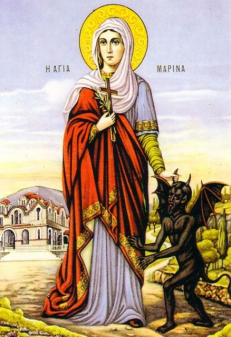 On this day, Apip 23rd (July 30th), is the commemoration of the martyrdom of the blessed St. Marina, who overcame the Devil. She was one of the daughters of the nobles of Antioch. Her parents were pagan. When her mother died, her father sent her to a nanny to raise her, who was a Christian. She taught Marina the Faith of Christ. When Marina reached the age of fifteen years, her father died. One day she heard her nurse talking about the biography of the martyrs and what glory they receive in the Kingdom of Heaven. She longed to become a martyr in the Name of the Lord Christ. One day St. Marina went out of her house with her maiden servants, and on her way she passed by Lopharius Ebrotus, the governor, who admired her much when he saw her. He ordered her brought to him. When the soldiers came to her, she told them that she was Christian. In turn, when they told the governor this, he was distressed for he liked her, and he had her brought to him by force. He offered her the worship of the idols and asked her to forsake God, but she refused. Then he asked her, "What is your name? and from where are you?" She told him, "I am Christian. I believe in the Lord Christ, and my name is Marina." He tried to persuade her by many promises and promised to marry her, but she did not heed him. When she cursed and insulted him, he ordered her body scraped with iron combs, then rubbed with vinegar, salt and lime, which they did. Nevertheless, she endured with patience. They cast her in prison, thinking that she was about to die. Immediately the angel of the Lord came, and healed all her wounds. While she was standing up praying, and her hands were extended in the form of a cross, a huge and terrifying serpent came forth. When she saw it she was frightened and her whole body trembled. The serpent swallowed her up, and her soul almost departed from her. She made the sign of the cross and prayed while she was in the belly of the serpent. It split open and fell on the ground dead. St. Marina went out unharmed.
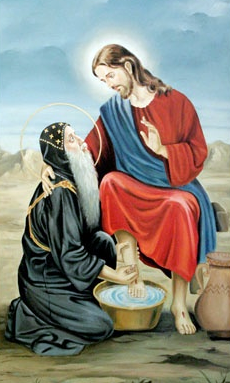 Saint Bishoy the Great is the founder of the monastery called after his name in Wadi El-Natroun. His name is "Bishoy" in Coptic, the equivalent of "Sammy", meaning just. In French his name is St. Paisious, and the church
mentions him in the liturgy as "The Perfect Man, the Beloved by our Good Savior" (al-ragol al-kamil habeeb mokhalisona al-saleh). He is also called "The Star of the Wilderness" (kawkab el-barieah).
Our saint was born 320 A.D. around the Nile's Delta in Egypt. His righteous mother raised him up, after his father's death, along with his six siblings. God has rewarded his mother for her well-upbringing of her children by sending to her His angels and chose Bishoy to become a servant for Him for the rest of his life.
In 340 A.D., when Bishoy was 20 years old, he went to the "Isqiet" wilderness and became a student of Saint Bimwa, who was a student of Saint Abu Makar the great. Over there, Bishoy, became a spiritual friend of the saint who was famous for obedience, St. Yuhanis the dwarf---who planted a dry stick in obedience of his teacher Saint Bimwa and it grew and became a fruitful tree through the blessing of his obedience.
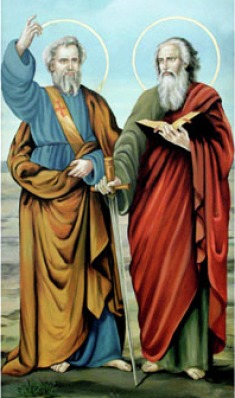 On this day, the two great saints Peter and Paul, were martyred. Peter was from Bethsaida, and he was a fisherman. The Lord chose him on the second day of His baptism after He chose Andrew his brother. He had fervent faith and strong zeal. When the Lord asked His disciples: "Who do men say that I am?" So they answered, "Some say John the Baptist, some Elijah, and others Jeremiah or one of the prophets." ... Simon Peter answered and said, "You are the Christ, the Son of the living God." (Matthew 16:13-20). After he received the grace of the Holy Spirit, he went around in the world preaching of the crucified Christ, and he converted many to the faith. God wrought great and innumerable signs and wonders by his hands. He wrote two catholic Epistles to the believers.
When he came to the city of Rome, he found there St. Paul the Apostle. Through their preaching, most of the people of Rome believed, so Nero seized Peter and commanded to crucify him. Peter asked them to crucify him head downwards, and he delivered up his soul into the hand of the Lord.
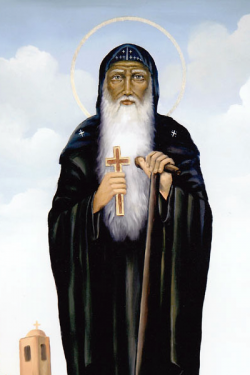 Saint Moses the Strong was martyred on the twenty-fourth day of the Coptic month Paona (July 1st).
St. Moses was born about 332 AD. In his youth, he was the slave of a high government official who could not tolerate St. Moses dishonesty and violence. It was even said that St. Moses went so far as to commit murder. Finally, his master drove him out of his house. St. Moses became the head of a gang of seventy robbers. He was a strong and fierce man of huge stature.
Once, as he was walking along the banks of the Nile, he spotted some sheep and a shepherd on the opposite side of the Nile. The Nile at that time was at full flood and more than a mile wide. St. Moses put his sword between his teeth and swam across the river. When the shepherd saw him, he ran away and buried himself in the sand. The sheep were left for St. Moses, who chose four of the best rams, slew them and tied them with a rope. He then carried them on his back and swam back across the river. He came to a small village where he skinned the rams, ate the best portions of them, and sold the rest for wine.
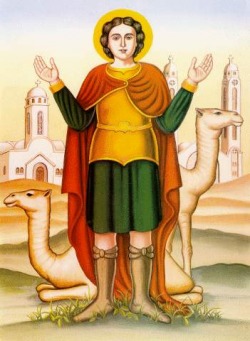 St. Mina the Wonder WorkerThe Lord Jesus Christ promises us, "He who believes in Me, the works that I do he will also do, and greater works than these he will do, because I go to My Father." (John 14:12)
The ministry of the Lord Jesus Christ was one of numerous occurrences of healings of "all kinds of sickness and all kinds of diseases." (Matthew 4:23) The Lord Jesus Christ healed not only sickness and disease but also darkened hearts and minds as He released people from demonic oppression.
Like their Master before them, the early Apostles participated in God's work of healing, giving all thanks to their miracles to the risen and ascended Lord Jesus Christ. In the Holy Book of Acts 9:34, St. Peter told a newly restored man who had been bedridden for eight years, "Jesus the Christ heals you."
|










 RSS Feed
RSS Feed